The humble ruler, an essential tool in nearly every classroom, office, and workshop worldwide, has a rich history. Originating from ancient civilizations, the first rulers were said to be made from ivory and wood. They used cubit rods to measure the dimensions of their monumental structures.

Over the centuries, this simple measuring device evolved into the precision tool we know today, made from various materials and featuring scales that accommodate both the Imperial and metric systems. This article delves into the diverse world of rulers, uncovering the differences between types of rulers that might seem superficially similar but serve distinct purposes.
Different Types of Rulers
Let’s explore the different types of rulers based on the material they are made from. Each material offers unique characteristics and advantages for various uses, from classrooms to professional workshops.
Classified by material

Wooden Rulers
Wooden rulers are the most traditional type, usually made from durable hardwoods such as oak or maple. These rulers are sturdy and comfortable to hold, and they are commonly used in educational settings due to their affordability and sufficient durability to withstand daily wear and tear from students.

Plastic Rulers
Plastic rulers are among the most common rulers in modern life due to their light weight, cost-effectiveness, ability to be produced in various colors, and transparency. Typically made from ABS or PVC plastic, these rulers are easy to carry and store, making them perfect for quick measurements and school projects. However, plastic rulers may not be as durable as wooden or metal ones.

Metal Rulers
Metal rulers are usually made from stainless steel or aluminum and represent the most durable rulers. They resist bending or breaking and are ideal for precision tasks such as mechanical drafting, construction, and woodworking. The scales on metal rulers are also less likely to wear off, making them the preferred choice for professionals.
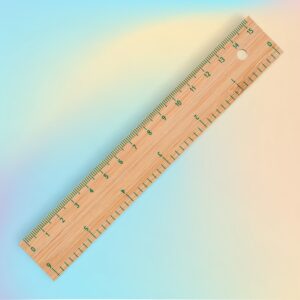
Bamboo Rulers
Bamboo rulers are an eco-friendly option that has gained popularity due to bamboo’s natural strength and sustainability. Similar in sturdiness to wooden rulers but lighter, they feature a unique natural grain and are ideal for those seeking environmentally friendly office or school supplies.
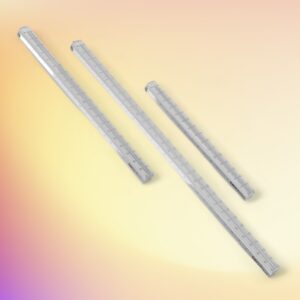
Glass or Acrylic Rulers
These rulers are often used in the arts and design fields, especially where precise alignment is necessary. They are transparent, allowing users to see through to the material beneath for accurate marking and measuring. These rulers are relatively fragile and must be handled carefully to avoid breakage or severe impacts.
Understanding the different material types of rulers and their properties allows users to choose the most suitable ruler based on their needs. Honeyoung, a stationery supplier, thinks each material has benefits and ideal applications; selecting the proper ruler can enhance work efficiency and ensure measurement accuracy.
Feature | Wooden Rulers | Plastic Rulers | Metal Rulers | Bamboo Rulers | Glass or Acrylic Rulers |
Durability | ★ | ★★ | ★★★ | ★★ | ★★★ |
Flexibility | Low | Moderate to high | Low | Moderate | Low |
Precision | ★★★ | ★★★ | ★★★★ | ★★★ | ★★★★ |
Weight | Light | Very light | Heavier | Light | Moderate to heavy |
Ideal Use | General educational use, crafts | Office, school, crafts | Engineering, drafting, construction | Crafts, light measuring tasks | Design, art, where clarity and durability are prioritized |
Pros | Economical, traditional look | Lightweight, often transparent | Highly durable, precise measurement | Environmentally friendly, sturdy | High durability, clear visibility, does not warp |
Cons | Can warp, break easily | Can scratch easily, may warp in heat | Can be heavy and cold to touch | Not as common, may splinter | Fragile, can shatter, expensive |
Classified by purpose
Let’s categorize types of rulers by their specific uses, highlighting how each type is designed to meet particular measuring needs across various fields and activities.
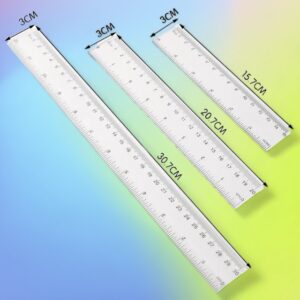
Standard Desk Rulers
Standard desk rulers are the most familiar rulers, typically measuring 12 inches (30 centimeters) in length. They are commonly used in schools for educational purposes, as well as in general office tasks. These rulers are great for simple tasks like drawing straight lines, measuring objects on paper, or as a straightedge for cutting.

Triangle Rulers
Triangle rulers, distinct with their triangular shape, are essential tools in technical fields such as architecture and engineering. These rulers come with various scales on each of their three sides to accommodate different measurement needs. Beyond professional use, triangle rulers are also popular in educational settings, helping students grasp concepts of geometry, including the properties and measurements of angles and lines.

Architectural and Engineering Scales
These specialized rulers, known as scale rulers, are essential in architecture and engineering. They feature multiple scales on a ruler, each corresponding to different architectural or engineering scales, such as 1/8 inch to 1 foot or 1:100 meters. These are used to read and create scaled drawings and blueprints accurately.

T-Squares
A T-square is a ruler used primarily in drafting and technical drawing. It consists of a long straight edge attached to a shorter one, forming a ‘T’ shape. T-squares are used to draw horizontal lines and ensure lines are perpendicular on large sheets, making them crucial in architectural and engineering drafting.
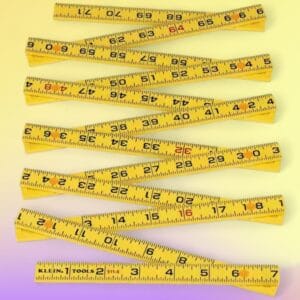
Folding Rulers
Folding rulers are designed for portability and can extend to measure longer distances, which makes them ideal for construction and carpentry. They can fold into a compact size, making them easy to carry and store. These rulers are typically made from wood or plastic and have joints that allow them to fold.

Yardsticks and Metersticks
Yardsticks and meter sticks are longer than typical desk rulers, measuring up to 36 inches (1 yard) or about 100 centimeters (1 meter). They are used in various tasks that require measuring more considerable lengths, such as in crafting, tailoring, or home decoration projects.
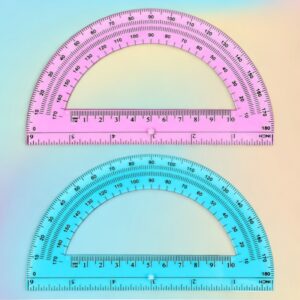
Protractors
Though not straight rulers, protractors are essential tools for measuring angles. They are usually semi-circular or circular disks marked with degrees from 0 to 180 or 0 to 360. Protractors are used in educational settings to teach angle measurement and in fields like carpentry and architecture to measure and draw angles accurately.

Before the advent of electronic calculators, slide rulers were the tool of choice for complex calculations. These analog computers are used for multiplication, division, roots, logarithms, and trigonometry. They consist of a fixed rule and a sliding central strip and are particularly valued by collectors and enthusiasts today.

Tailor’s Tape Measures
Tailor’s tape measures are specifically designed for measuring human bodies and fabric. They are flexible and soft, generally made from cloth or fiberglass, which allows them to contour comfortably around the body’s curves. Tailor’s tape measures typically feature measurements in both inches and centimeters and are essential in fashion design and tailoring to ensure garments fit correctly.
Each type of ruler and measuring tool serves a unique purpose, enabling precision in various professional and hobbyist contexts. Tailor tape measures are indispensable in fashion and garment making, where flexibility and accuracy are paramount.
Two primary measurement systems used in rulers
Here’s an introduction to the two primary measurement systems used in rulers: Imperial and Metric.
Imperial Rulers
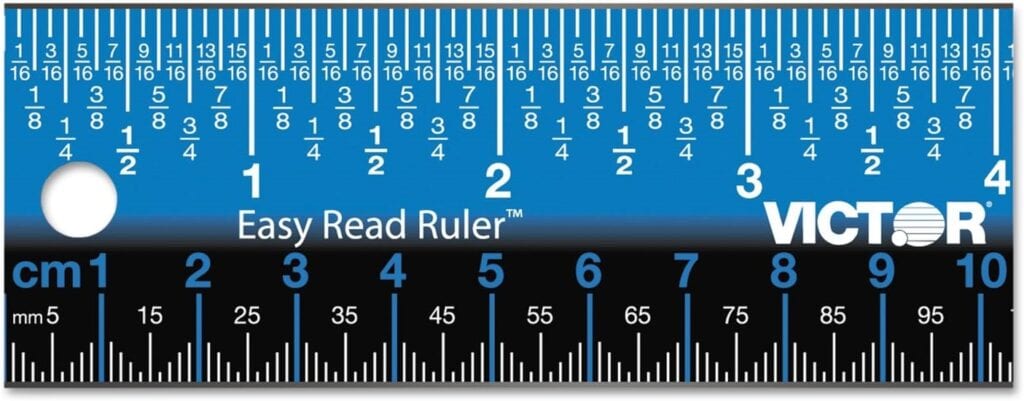
Imperial rulers use the Imperial measurement system, primarily used in the United States. These rulers are marked in inches and fractions of an inch, further divided into halves, quarters, eighths, sixteenths, and sometimes even smaller divisions.
- Units: The basic unit of length is the inch. Standard lengths on an Imperial ruler include 1 inch, 6 inches, and 12 inches (1 foot). Yardsticks, measuring 36 inches (1 yard), are also part of this system.
- Applications: Imperial rulers are widely used in fields such as construction, woodworking, and domestic crafts in the United States. They are also used in education within the U.S. to teach students about linear measurement.
- Advantages: Precision for Common Tasks: The division into smaller fractions can provide precise measurements, which is beneficial in carpentry and other crafts where exact measurements are critical.
Metric Rulers

Metric rulers use the Metric system of measurement, which is internationally recognized and used in almost all countries worldwide, except for a few, such as the United States. These rulers are marked in centimeters and millimeters.
- Units: The basic unit of length is the meter, but most common metric rulers are divided into centimeters (100 per meter) and further into millimeters (10 per centimeter).
- Applications: Metric rulers are used globally in science, engineering, healthcare, and education. They are preferred for their simplicity and ease of conversion in exact fields, such as scientific research and international trade.
- Advantages: Ease of Conversion: The decimal system in metric measurements makes converting between units (e.g., from millimeters to meters) more accessible. This is particularly useful in technical and scientific fields where frequent length measurement calculations occur.
Here’s a comparison table that outlines the critical differences between Imperial and Metric rulers. This table highlights their features, advantages, and typical applications, providing a clear distinction to help choose the right one based on measurement preferences and requirements.
| Feature | Imperial Rulers | Metric Rulers |
|---|---|---|
| Measurement Units | Inches and fractions of an inch | Centimeters and millimeters |
| Precision | High, with fractions for more detailed measurements | High, uses a decimal system for simplicity |
| Common Lengths | Typically 6 inches, 12 inches, 36 inches (yardstick) | Commonly 15 centimeters, 30 centimeters, 100 centimeters (meterstick) |
| Primary Use | Predominantly used in the United States for construction, crafts, and education | Widely used internationally in science, engineering, and education |
| Advantages | Familiar system in the U.S., precise for detailed projects | Easy conversion between units, preferred in scientific contexts |
| Disadvantages | Conversion between units can be complex | Less familiar in the U.S., may require conversion for U.S.-based applications |
| Countries Using | United States, Liberia, Myanmar | Almost all other countries globally, including China, Europe, Canada, Australia |
In conclusion, Imperial and Metric rulers have unique advantages and applications. The choice between them usually depends on the geographical location and the specific industry standards. Understanding both systems is beneficial, especially in a globalized environment where both systems are often used in different contexts.
How to Use a Ruler
Whether you are a student in school who needs to use a ruler or you already work in the office and need a ruler to assist you, using types of rulers correctly is essential for accurate measurements. Most types of rulers now include both metric and imperial systems. Here is a guide on how to effectively use a ruler with two measurement systems:
Some Tips
- Measuring Circles: To measure the diameter of a circle, line up the zero mark of the ruler at one side of the circle and measure straight across to the opposite side.
- Incremental Measurements: When measuring long distances that exceed your ruler’s length, make a small mark at the end of the ruler, then move the ruler along the object to continue measuring from that mark.
- Protractors: Often combined with rulers, protractors are used for measuring and marking angles. Align the baseline of the protractor with one line of the angle, and use the degree markings to determine the angle’s size.
If you would like some product recommendations for ruler sets, please click here: ruler set.
FAQ
How do I choose between a metric and an imperial ruler?
Choosing metric and imperial rulers often depends on your regional measurement standards and specific needs. Metric rulers (centimeters and millimeters) are generally used internationally and are favored in scientific and technical fields due to their ease of conversion. Imperial rulers (inches) are predominantly used in the United States and in industries like construction and crafts, where traditional measurements are standard.
Can I choose the material for my custom ruler?
Yes, most manufacturers offer a variety of materials for custom rulers, including wood, plastic, metal, and even eco-friendly options like bamboo. The choice of material can depend on your budget, the intended use, and specific aesthetic preferences.
Can I use a ruler to measure angles?
A standard ruler cannot measure angles; many rulers come with integrated protractors. Alternatively, you can use a separate protractor with a straight ruler to accurately measure and draw angles.
Can rulers wear out?
Yes, especially plastic rulers. They can become scratched or bent. Metal rulers are more durable.
How do I ensure accurate measurements with a ruler?
To ensure accuracy, always align the zero mark of the ruler precisely with one end of the object being measured. Avoid parallax errors by looking straight down at the ruler. For precise tasks, consider using a ruler with finer graduations, such as a metal ruler that may offer increments as small as 1/64 inch or 0.5 mm.
What should I do if my ruler starts at 1 instead of 0?
Some rulers have a slight space before the first measurement mark to account for the physical thickness of the ruler’s end, often seen in tape measures. If precise measurements are required, always compensate for this offset by starting from the actual zero point or choosing a ruler that begins at zero.
How do I measure internal dimensions using a ruler?
To measure internal dimensions, like the inside of a box, use a flexible tape measure or a ruler with a butt-end that allows you to accurately position the zero mark against one side of the object. Alternatively, you can use the subtraction method with a standard ruler by measuring the external dimensions and then subtracting the thickness of the walls.
Are there digital rulers?
Yes, digital rulers and apps can provide measurements and digital readouts, which are helpful for quick estimates or when traditional rulers are not handy.










